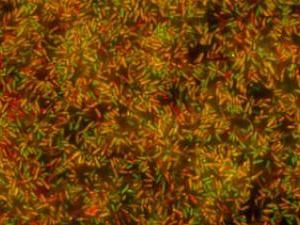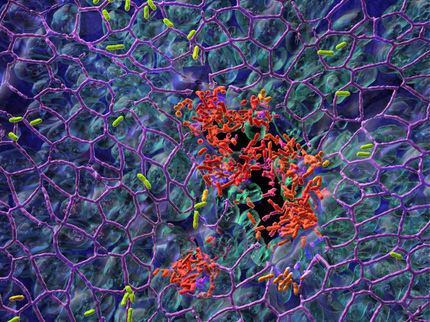Drug works against 'superbug' biofilms and respiratory virus
Advertisement
A potential drug therapy developed at the University of Pittsburgh Center for Vaccine Research (CVR) has proven effective against tough bacterial biofilms and a deadly respiratory virus simultaneously. The drug outperforms traditional therapies in the laboratory setting.

Pseudomonas aeruginosa killed by the engineered cationic antimicrobial peptide (eCAP). Killed bacteria (red), living bacteria (green).
Jeffrey Melvin, Pitt
The results build on a recent discovery from Pitt's School of Medicine showing that the virus encourages biofilm growth and point to a new way to treat drug-resistant bacteria, including so-called "superbugs" that are resistant to almost all existing antibiotics and have become the focus of worldwide efforts to limit their spread.
"This is really unusual. To the best of our knowledge, no other antibiotics out there work on both the bacteria and the virus during a co-infection," said senior author Jennifer M. Bomberger, Ph.D., assistant professor in Pitt's Department of Microbiology and Molecular Genetics. "Antibiotic-resistant chronic infections are an urgent public health threat, and the development of new therapies has been painfully slow. So to see something work on a virus and the incredibly resistant biofilms that bacteria form is very exciting."
Chronic infections, such as those that kill cystic fibrosis patients, resist the body's efforts to clear them from the lungs, sinuses or other areas. Often these infections are characterized by biofilms, which are bacteria that stick together forming colonies that are as much as 400 times as resistant to antibiotics as a single bacterium.
The potential drug therapy relies on an engineered cationic antimicrobial peptide, or "eCAP," which is a synthetic and more efficient version of naturally occurring antimicrobial peptides that form a first line of defense against infections in humans. Developed by co-author Ronald C. Montelaro, Ph.D., professor and co-director of Pitt's CVR, the eCAP works by "punching into" bacteria and viruses, thereby destroying them.
Dr. Bomberger and her team tested the eCAP in the laboratory by growing biofilms of drug-resistant Pseudomonas aeruginosa bacteria on the cells that line the airway and then treating them for one hour with the eCAP. The eCAP was 50 times more effective at fighting the biofilm than traditional treatment, but did not harm the airway cells.
The team then did the same test, this time on airway cells first infected with respiratory syncytial virus (RSV), which causes serious infection in infants and older adults, as well as people with compromised lungs.
"When the body responds to fight the virus, it inadvertently leaves an Achilles heel by fostering an environment rich in the nutrient iron, which aids the bacteria in forming a biofilm," said Dr. Bomberger.
The eCAP was 10 times more effective at fighting the biofilm in a virus-bacteria co-infection compared with traditional therapy. And when the eCAP was used on airway cells infected only with RSV, the number of viable virus particles was reduced by more than 150-fold.
The eCAP also worked against bacterial biofilms grown on plastic, indicating that it could be a good treatment for cleaning medical equipment, such as bronchoscopes, where biofilms sometimes grow.
"We're incredibly encouraged by these results," said Dr. Montelaro. "Again and again, eCAPS are performing well in laboratory tests and mouse models. They're an exciting possibility to help solve the antimicrobial-resistant superbug crisis that our world increasingly faces."


























































